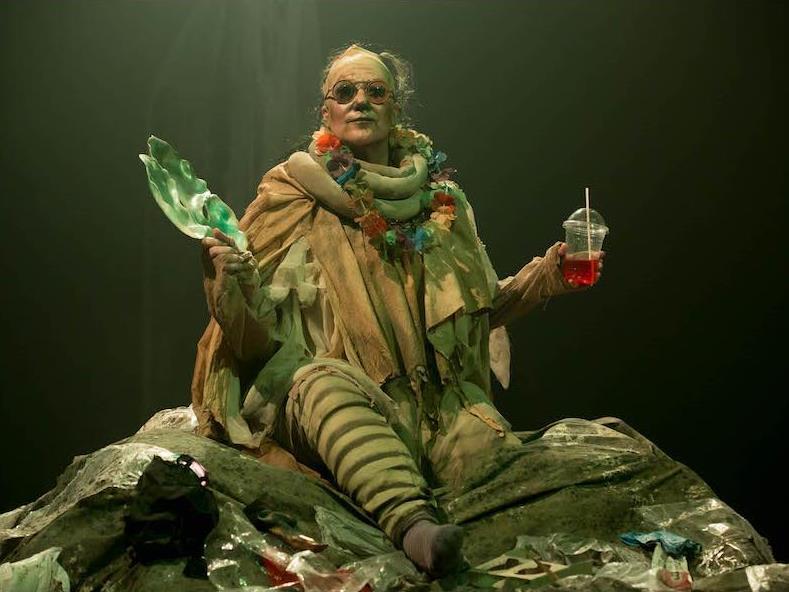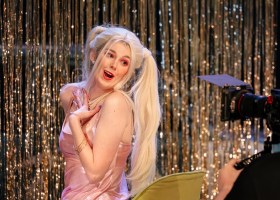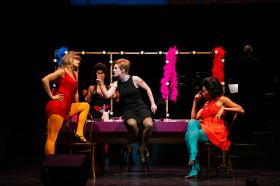Nathan Kelly Photography
One form of playwriting that is in short supply in Australian drama is the theatre of wit and word-play. Where is the Australian Oscar Wilde, the Australian Noel Coward, the Australian Tom Stoppard? Not easily found, I submit. That is where Kathryn Ash’s new play breaks virtually untilled ground, referencing Samuel Beckett’s Waiting for Godot but in an amusing rather than a mystifying way, and shamelessly pinching lines all over the place from Shakespeare, but mainly from Hamlet.
Its opening line is that which opens Hamlet’s most famous soliloquy, “To be or not to be …”, and which sets the theme for the whole play. Yes, this is a treatise on that age-old question, and a jolly romp it is through the works of the bard as it explores the deepest question of all. What does lie beyond that bourne from which no traveller returns? Should that concern us, or should we ask rather what is our purpose in this life? What were we put here (“assembled”) to do? And what, if anything remains after we have done it? What is the one human quality that remains, unchallenged, at the end? These are the questions the play tackles.
The work was written to suit the particular circumstances of its lead actor, Doug Robins (Jabba) who is confined to a wheelchair with Duchenne Muscular Dystrophy, a degenerative disease that is slowly creeping up on him. Jabba’s companion, Poker, played by Natalie Taylor is the perfect foil, a Stan Laurel to Jabba’s Oliver Hardy. He (or she, the character is androgynous) is always on the move, trying desperately to minister to Jabba amidst the decay and detritus of a dying civilisation. Ours, to be precise, at a point in the future when environmental neglect has produced its inevitable messy outcome. The pair keep each other occupied arguing philosophical propositions – arguments in which Poker always comes off second best, because she’s not all that bright. Her (or his) intelligence is emotional rather than intellectual.
The stage setting for all this is stunning. The designers, Simone Tesorieri and Simona Cosentini have excelled themselves, producing a giant, smoking scrap-heap punctuated here and there with piles of rotting dung and overhung at the rear by a giant screen on which is depicted a fish, which rots in front of our eyes as the play progresses. The sound and audio aspects of the play are quite demanding, but they are very well handled by a team of three – Jason Glenwright (Lighting Design), Craig Wilkinson (Video Design), and Guy Webster (Sound Design).
For the first half of the play, I found myself wondering if the two characters on stage were differentiated enough to create the conflict on which all drama depends – and if Doug Robins’ low-key delivery of his lines, in particular, would maintain my interest for the whole play. I need not have worried. In mid-stream, the play takes a new turn with the arrival of Fucker, the Worm, played with comic panache by Barbara Lowing. Here is a character to die for (literally, as Poker nearly finds out). Lowing’s performance is a comic masterpiece with perfectly timed and nuanced dialogue largely dominated by thoughts of death and decay. Even so, she can manage to laugh, because there’s a gallows humour in her, and it’s irrepressible. And there’s a flow-on effect at play’s end, as if the Worm’s energy is absorbed by osmosis, with Jabba delivering a memorable soliloquy of hope with all the strength he can muster.
Matt Scholten, now resident at USQ in Toowoomba, but formerly artistic director of IF Theatre in Victoria, brings with him a keen sensitivity to the Shakespearean language of the play. Much of Kathryn Ash’s dialogue has a marked Shakespearean flavour. Now and then, a line we recognise as a quotation pops out, but the quotation we are expecting to hear turns on its head with a twisted logic. Here’s an example. Jabba is bewailing his fate early in the play:
“This goodly frame here, look you – ! two legs cannot stand me, two arms do nought to arm me!
Here sit I, betrayed by nature and squarely confined by egregious malfunction upon this throne.”
This type of dialogue runs as a river of allusion through the play. It is what makes it so rich and multifaceted. Scholten has succeeded in having his actors make it sound just right – neither over-the-top Pommy, nor false ‘elocutiony’. There is also his close attention to detail throughout in matching the changing moods of the play to the ongoing decay all around, through lighting, sound, and his use of the acting space on the set. The symbols of decay – the fish, the grinding of gears as assembled parts disassemble – these are nicely pointed.
While it takes a spectator who is well acquainted with Hamlet and the devices of the modern theatre to take in the total impact of the play, Scholten kept the laughs coming at just the right intervals to amuse even the least experienced theatregoer. The succession of fart definitions in the second part of the play was hilarious. Yes, the audience on opening night enjoyed the play immensely to judge by the thunderous applause at the end. It is a rare treat to be able to attend a play so full of wit and repartee. Take the chance to see it while you can.
4 stars out of 5
Here We All Are: Assembled
By Kathryn Ash
A JUTE Theatre Company Production
29 September – 10 October 2017
JUTE Theatre, Centre of Contemporary Arts
96 Abbott Street, Cairns






